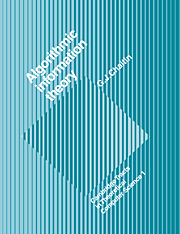Book contents
B - The Number of S-expressions of Size N
Published online by Cambridge University Press: 23 November 2009
Summary
In this appendix we prove the results concerning the number of S-expressions of a given size that were used in Chapter 5 to show that there are few minimal LISP programs and other results. We have postponed the combinatorial and analytic arguments to here, in order not to interrupt our discussion of program size with material of a rather different mathematical nature. However, the estimates we obtain here of the number of syntactically correct LISP programs of a given size, are absolutely fundamental to a discussion of the basic program-size characteristics of LISP. And if we were to discuss another programming language, estimates of the number of different possible programs and outputs of a given size would also be necessary. In fact, in my first paper on program-size complexity [CHAITIN (1966)], I go through an equivalent discussion of the number of different Turing machine programs with n-states and m-tape symbols, but using quite different methods.
Let us start by stating more precisely what we are studying, and by looking at some examples. Let a be the number of different characters in the alphabet used to form S-expressions, not including the left and right parentheses. In other words, α is the number of atoms, excluding the empty list. In fact α = 126, but let's proceed more generally. We shall study Sn, the number of different S-expressions n characters long that can be formed from these a atoms by grouping them together with parentheses. The only restriction that we need to take into account is that left and right parentheses must balance for the first time precisely at the end of the expression.
- Type
- Chapter
- Information
- Algorithmic Information Theory , pp. 167 - 175Publisher: Cambridge University PressPrint publication year: 1987



